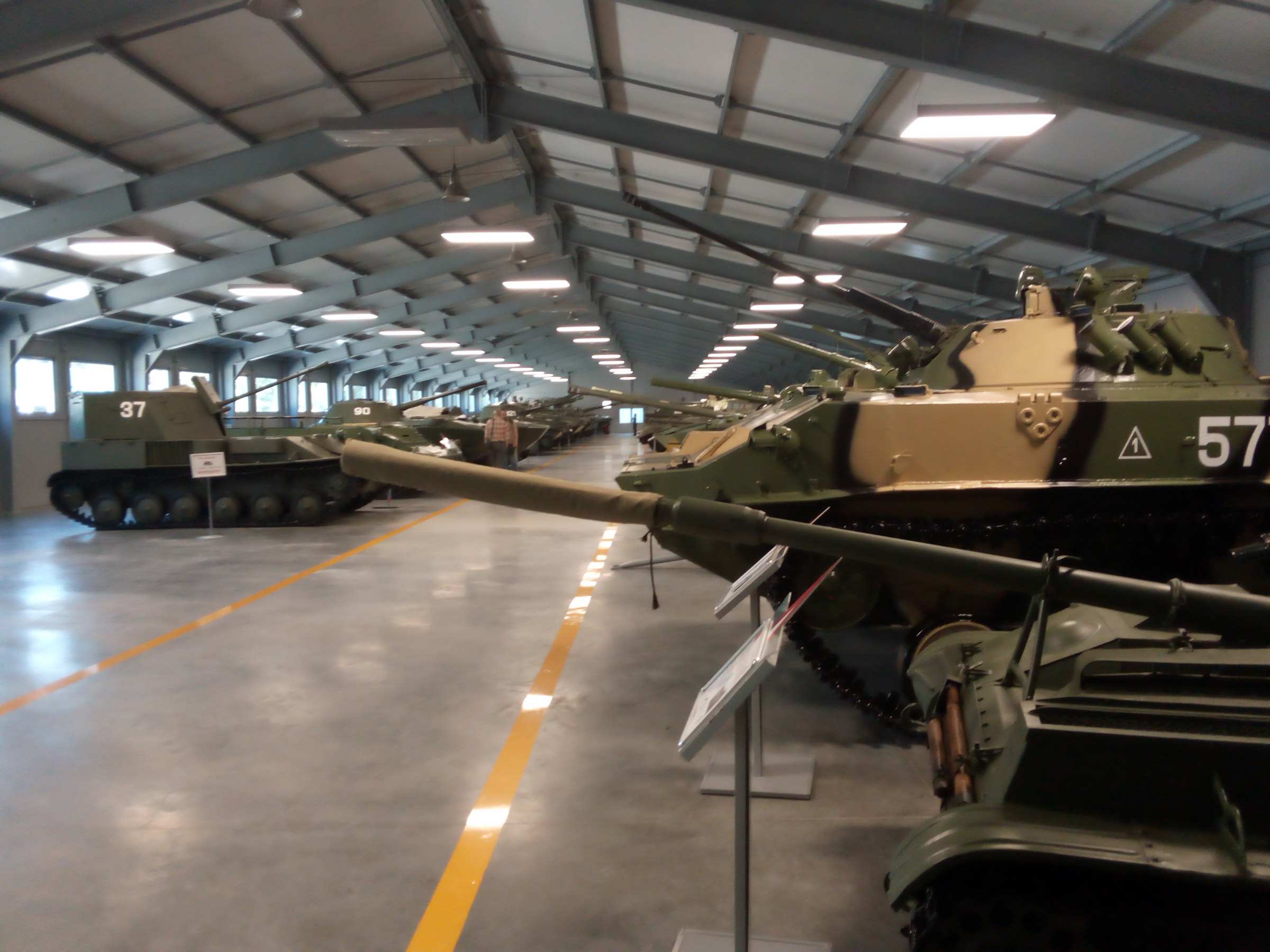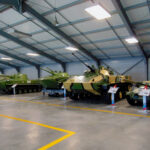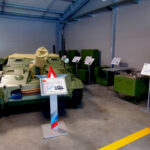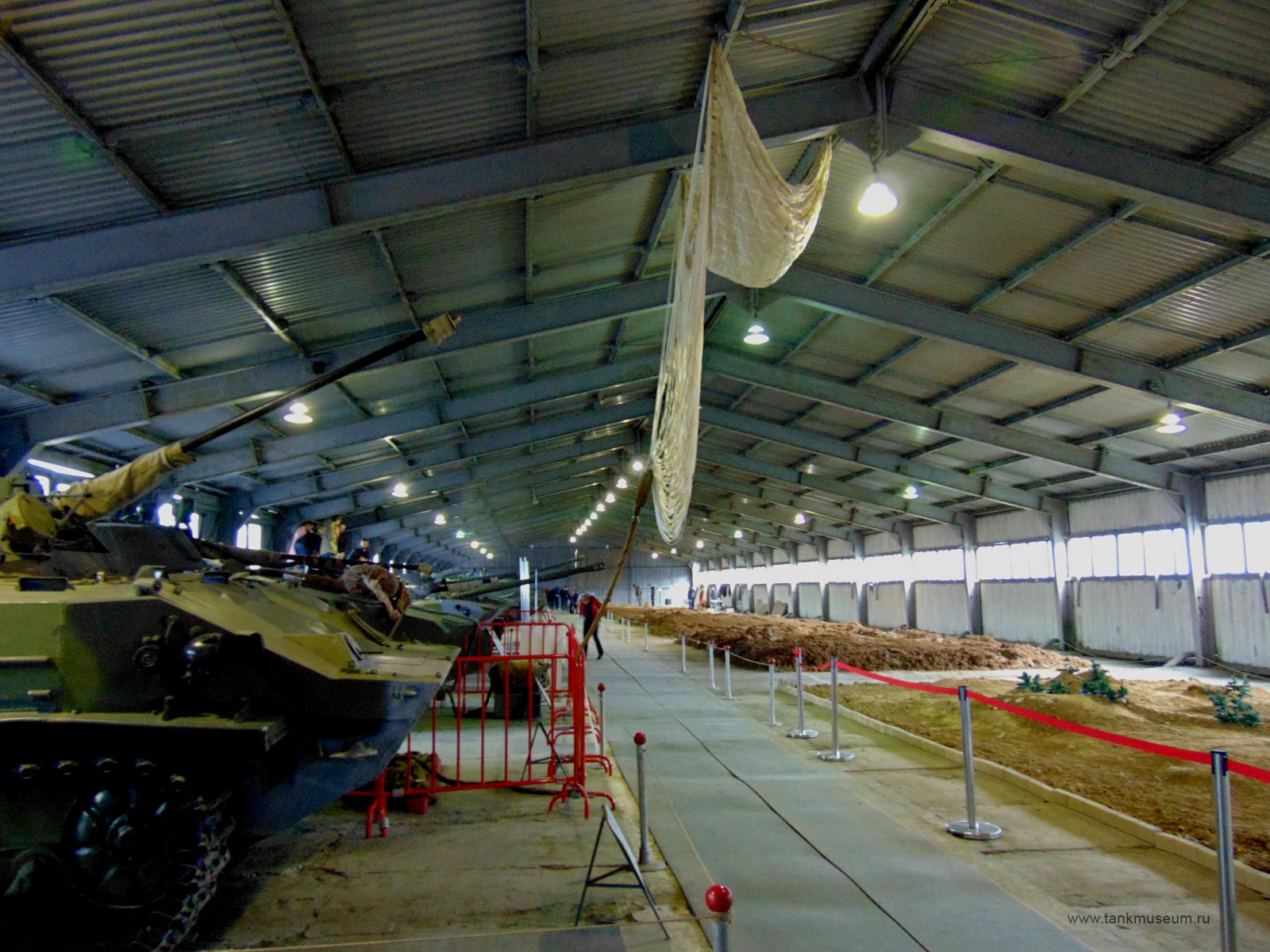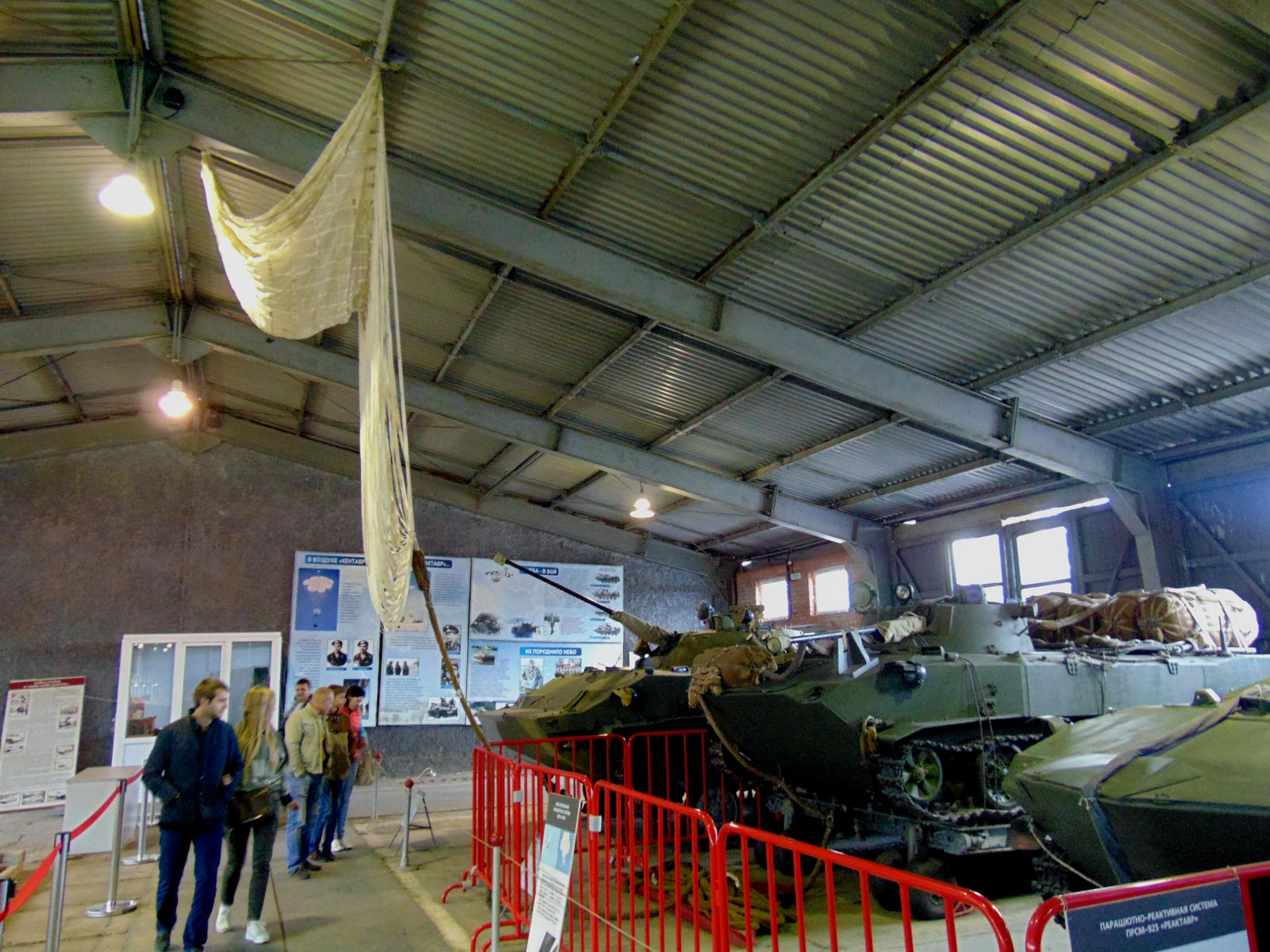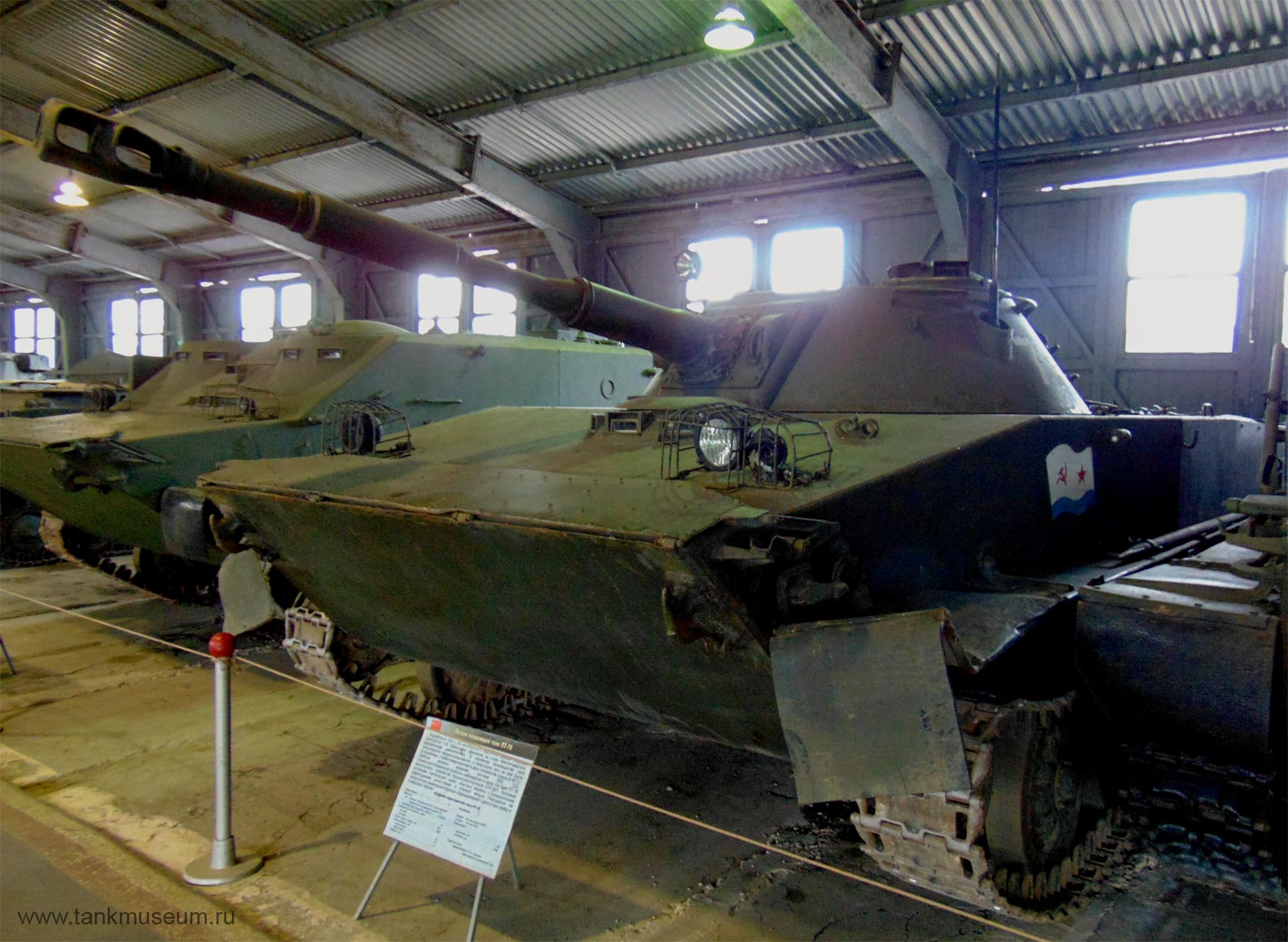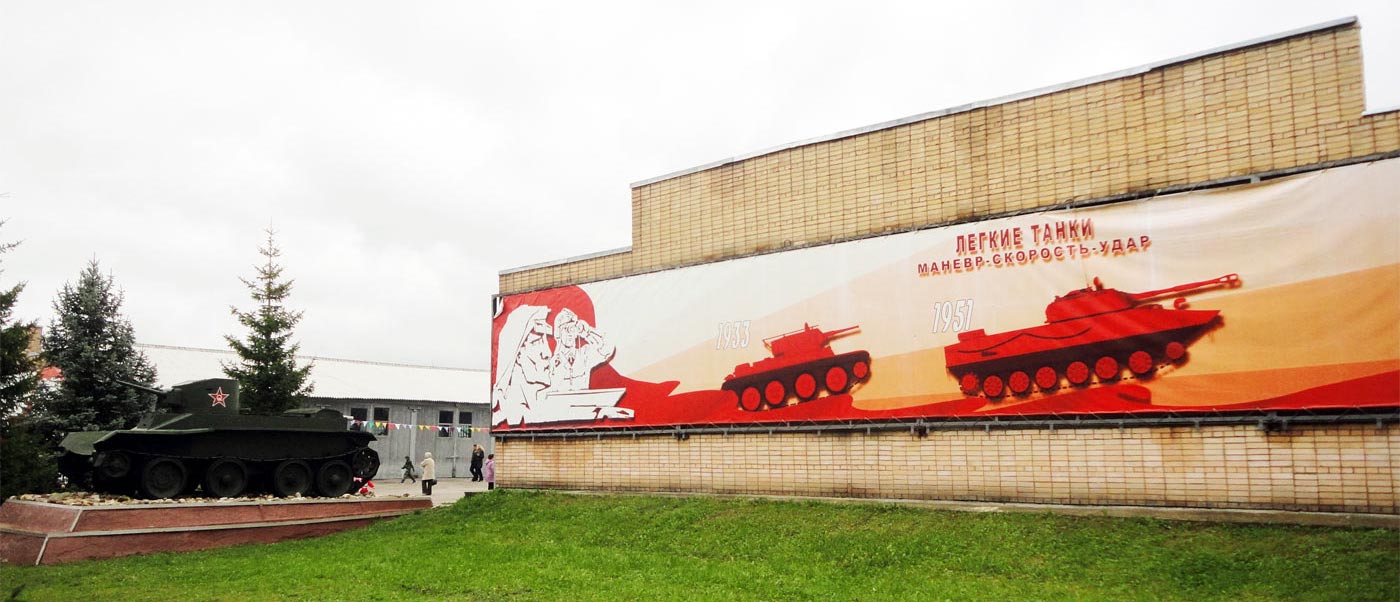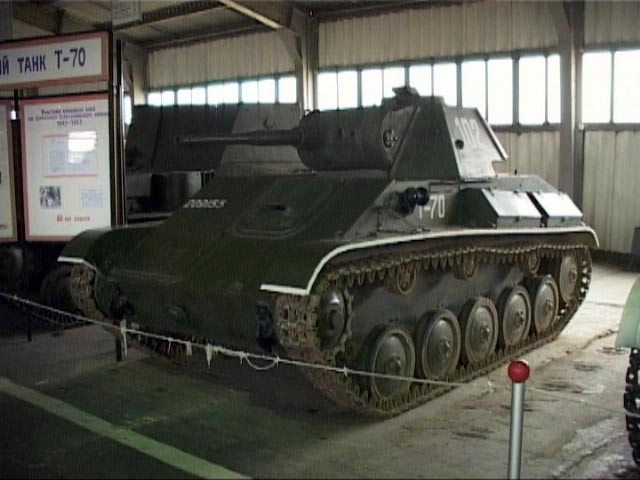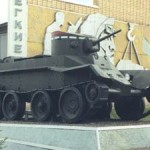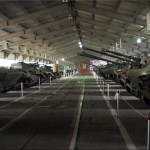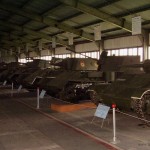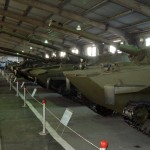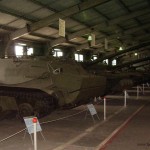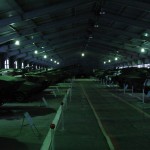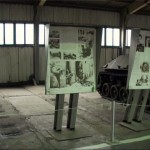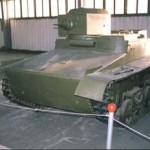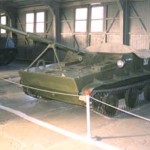Tank museum, Kubinka. Soviet Light Tanks, Assault Guns and Carriers, Pavilion N 3 exhibits.
Armored Vehicles of the World War two, Cold War and the Local Conflicts:light tanks, airborne combat vehicles (BMD), armored personnel carriers (BMP).
- VDV vehicles
- Generak view
- ASU-57 and field kitchen
- airborne self-propelled
History of the pavilion N 3. Virtual tour on the tank museum 1972-2014
“Pavilion No. 3 impresses with a variety of light armored vehicles with the most unexpected combat qualities and their combination.This variety is modestly supported by the only two tank T-26 tanks preserved in the world. Here is the T-70 tank, a participant in the heavy battles of 1942 in the area of Velikiye Luki , which for 60 years lay in a swamp and a group of enthusiasts have been restored and put back into operation.Why do you like tanks of marines, which today do not have equal tanks (tanks) all over the world.? The tanks of the winged infantry are BMD, a kind of small brisk weight A mobile floating tank bristling with a complex of missile-cannon-machine-gun weapons You can imagine yourself being loved in the place of the driver-mechanic of the combat vehicle when the “aluminum tank”, being pulled out of the belly of a military transport aircraft, on one dome of the parachute, in almost free fall, gaining speed of 9 floors per second falls into the abyss? Such systems failed to create any country in the world. ” (colonel Boris Ozerov)
“Soviet light tanks, AF, BMD, BTR-D”, photo archives of the hall before 2014
The official catalog of the museum (**) of Pavilion N3
“Soviet light tanks, self-propelled units, landing vehicles and BTR-D” *** (prepared by Mikhail Blinov)
N – Brand —- Object — Year of manufacture — Designation – type of production
- Т-27, — , 1931, tankette, serial
- T-26, — , 1932, light two-turret tank, serial
- T-26, —- , , light tank, serial
- OT-130, — , 1938, flamethrower tank, serial
- BT-5, —- , 1933, wheeled tracked tank, serial
- T-37A, — , 1933, amphibious tank, serial
- T-30, — , 1940, light tank, small serie
- T-40, — , 1940, amphibious, serial
- T-126, — , 1940, light tank, single sample
- Т-50, — , 1940, light tank, small serie
- T-60, — , 1941, light tank, serial
- T-70, — , 1942, light tank, serial
- ZSU-37, — , 1944, anti aircraft gun, serial
- SU-76, — , 1943, assault gun, serial
- T-80, — , 1943, light tank, small serie
- K-75, — , 1947, tracked armored carrier, one sample
- K-78, — , 1950, tracked amphibious armored carrier, one sample
- K-90, — , 1950, light amphibious tank, single sample
- PT-76, Object 740B, 1951, light amphibious tank, serial
- ZPTU-2, Object 750, 1955, anti aircraft on the base BTR-50P, small serie
- ZPTU-4, Object 750, 1959, anti aircraft assault gun on BTR-50P, small serie
- BTR-50PK, Object 750PK, 1957, amphibious tracked armored carrier, serial
- BTR-50PN, Object 750 (905),1960, commander carrier, serial
- PT-76M, Object 907, 1960, light amphibious tank, single sample
- PT-85, Object 906, 1963, light amphibious tank, one sample
- -, Object 685, 1976, light amphibious airborne tank, one sample
- -, Object 934, 1975, light amphibious airborne tank, one sample
- -, Object 940, 1976, commander carrier, one sample
- ASU-76, Object 570, 1949, airborne assault gun, single sample
- ASU-57P, Object К-73, 1949 (?), amphibious assault gun, one sample
- ASU-57, Object 572, 1951, light airborne assault gun, serial
- ASU-57P, Object 574, 1954, amphibious airborne assault gun, single sample
- SU-85, Object 573, 1956, light AG, serial
- BMD-1, Object 915, 1969, fighting paratrooper vehicle, serial
- BTR-D, Object 925, 1974, paratrooper armored carrier, serial
- BREM-D, — , 1984, armored recovery vehicle, serial
- BMD-2, Object 916К, 1986, combat paratrooper vehicle, serial
- BMD-3, Object 950, 1986, same
- BT-2, — , 1931, wheeled / tracked tank (on monument outside), serial
* – there are some inaccuracies in the Catalog, corrections and clarifications in the possibility are also given
** – from January 2012 – “Central Museum of Armored Weapons and Equipment”
*** – this official catalog includes all the samples of the 3 pavilions that were in it since the museum was founded (1972) until its “reorganization” (2014). At the moment, most of the rare pre-war equipment in the pavilion is missing. The right half of the pavilion is occupied by a playing field for fans to play in controlled models of tanks.
Some samples were temporarily moved to Patriot Park and other museum pavilions (N4)
Time Machine. Back to the past of the pavilion.
This pavilion is most changed till 2014. Recently, the right half of the pavilion has been cleared from the lungs of Soviet tanks (pre-war) and organized the games site for the bench moving models. The former exhibits of the pavilion are scattered in different places, including 15 kilometers (in the park, “The Patriot” and repair hangars). We display the official exhibits catalog, which were here in the years since 1972 till 2014, and the archival and the modern photos of this pavilion.
2016. For the summer of 2016 only the left half of the pavilion left with the VDV technique. All armored vehicles of the Second World War were taken to different places, partly to the Patriot Park, partly to other pavilions, and a bit overhaul shops.
Recently, the right half of the pavilion has been cleared of light Soviet tanks (pre-war period) and a gaming range for bench moving models is organized.
Hall N3, the modern view in 2015. Note the right side was changed into the scale-model polygon.
Soviet light tanks began to develop following the results of the First World War. France and Poland produced tanks to support cavalry. And in these times the Red Army considered Poland as the main potential LDP. In the UK, light tanks of the Karden-Loyd-Vickers type were purchased for study, and in the United States two samples of the Christie automobile tank. From 1931-38, through the creative development of foreign experience, various first Soviet light tanks for reconnaissance, support of cavalry and infantry were manufactured. Some models were floating. In the pavilion there are tank-amphibians T-37A and T-40 (designer AN Astrov). At the beginning of the war, the T-40 amphibian was transformed into a land T-40S and on its basis began to develop a “line” of light tanks T-30, T-60, T-70 with car engines. These tanks are also represented in the pavilion.
For delivery to the guerrillas and landing in the rear of the enemy in late 1941, designers were given a task to develop a towed airframe. Oleg Antonov, an aircraft designer, was one of the founders of Soviet gliding. He suggested an interesting variant of transportation of a tank equipped with wings, in tow behind the plane (project A-40 “Wings of the Tank”). The design was extremely simple and cheap. The tank had to detach from the towing aircraft for 20-30 km from its destination, move silently, make landing and, dropping its wings, engage in battle. The first flight took place on September 2, 1942.
After the evacuation of the factories to the Urals, light tanks T-50, T-60, T-70 and T-80 were produced. They were also intended to directly support the infantry. Manufactured more than 14,000 light tanks. Tanks T-70 participated even in the Kursk arc. For the tactics of fighting the “pack,” the Germans called them “locusts.” After the Kursk arc, the chassis of these tanks were used for the production of self-propelled guns with guns of 76 mm.
T-26, designed to directly support the infantry, is presented in two versions (with one and two towers). This is so widely known for the civil war in Spain. Developed on the basis of a six-ton tank of the British company Vickers. In 1938, the telescopic sight of the TOC was installed on the tank with stabilization of the aiming line in the vertical plane. In total, more than 11,000 tanks of this type have been produced.
BT (high-speed tank) – was developed to interact with the cavalry on the basis of the “Christie” tank. After removing the tracks for about twenty minutes, this tank could rush along the M1 highway to Warsaw and Berlin as a high-speed car. The tank was produced in 4 main modifications: BT-2, BT-5, BT-7, BT-7M. They had exceptional speed data (on tracks up to 55 km / h, on rinks up to 75 km / h) and good cross-country ability. BT tanks were produced around 8,000, only a few survived. By the end of 1942, they were almost all destroyed. One of the preserved stands on a monument in Mongolia.
In the postwar period, based on the experience of war, as well as some new tasks, a lightweight floating PT-76 tank (lead designer NV Shashmurin) was created.
PT-76 is the first domestic tank designed for land, airborne troops and marines, for fighting in different LDP, where the conditions of the terrain, the use of major tanks is difficult. For the first time in the world a water cannon was used as a propulsor on water, which allowed using the tank not only on open, but also waterlogged reservoirs. Until now, for tanks of this class on patency it has no equal in the world. The tank since 1951 to the present time is on the armament of the army. On the basis of the PT-76 tank, armored personnel carriers BTR-50P, BTR-50PK, tactical missile launchers, command and staff vehicles,
The experience of light tanks of the beginning of the Great Patriotic War and even elements of their designs were again in demand during the development of technology for the Airborne Forces. Until the mid-sixties, the airborne troops (“Uncle Vasya’s troops” -the commander of Colonel-General Vasiliy Margelov) were equipped with ultra-light self-propelled artillery systems of 76 mm and 57 mm caliber, created on the basis of automobile units and units, and even 85 ms SU-85 (15 tons) on the original base using elements of light tanks of the T-30-T-40-T-60 series. Since the mid-sixties new special combat vehicles for landing with powerful weapons have already been developed: BMD-1, BTR-D (caterpillar floating amphibious armored personnel carrier), Nona S, BMD-2 with 30 mm automatic cannon.
At the beginning of 1972, they began to test BMD (landing combat vehicle) first on a special test bench, and then dropping it from an airplane on special shock-absorbing platforms weighing two tons. When landing, the huge dome of the parachute covered the technique, and the lines became entangled and fell under the tracks and skating rinks. In addition, after the dump of the combat vehicle, the crew jumped after it. Back in the 1960s, the commander of the Airborne Forces, General of the Army, Margelov, had the idea of landing troops directly in technology. Paratroopers sitting in their BMD, immediately after landing, go on the attack.
On January 5, 1973, ANT-12 lifted BMD with its crew inside. In the space armchairs the commander of the crew Lieutenant-Colonel Leonid Zuev, the gunner-operator – Senior Lieutenant Alexander Margelov (the son of the commander of the Airborne Forces, General of the Army Vasily Margelov) was sitting at the place of the driver.
Five huge parachutes slowly lowered the BMD … which flew by the wind for many kilometers from the proposed landing point. Thus, the multi-dome parachute system “CENTAUR” allowed to assault the crew inside the BMD, but the accuracy of the landing was far from ideal.
And if instead of a dome system there is only one light parachute installed? Then the combat vehicle will descend four times faster, and, therefore, more accurately. The vertical speed at the moment of landing can be extinguished due to the operation of special brake motors.
On January 23, 1976, near Pskov, above the parachute radar of the 76th Guards Airborne Division, the BMD dropped out of the hatch of the military transport aircraft and, braking just one parachute, rushed to the ground, quickly gaining the speed of almost free fall. The reactive braking system worked well. The car immediately wound up and rushed to the firing line, where the crew shot perfectly. The task of landing BMD with a part of the crew inside the parachute-reactive system (ORS) – without a platform was solved. The program was called “REACTAVR” (jet centaur). The crew included Alexander Margelov and Leonid Shcherbakov. Twenty years after this event, for their courage and heroism, they were awarded the title Heroes of the Russian Federation.
Since 1976, the Airborne Forces have adopted the reactive-reactive systems “REACTAVR”, which allowed to reduce the time for the collection of personnel and equipment on the landing site after landing to tens of minutes.
Airborne Forces of the Russian Army
BMD-3 (designed by AV Shabalin) is made with an aluminum alloy body, powerful weapons, an improved chassis, excellent hydraulics and universal seats with an amortization system that allows them to parachute these vehicles with a crew and landing “from heaven to battle” . There was a real opportunity to drop the crew inside the car in its entirety – all seven people!
On August 20, 1998, for the first time in the world, such landing in the course of conventional exercises was carried out by the 104th Guards Regiment. Mobility and patency of domestic cars of light weight category is much better than the best analogues of foreign production. Such systems are the pride of Russia, the masculinity of the paratroopers, the heroism of the testers, the highest intellect of the creators of military equipment, unsurpassed domestic technologies. After all, no one in the world, either in America, Germany, the UK, or France has been able to solve this problem. If you believe the foreign press, the French military had such an attempt, but it did not end with success (tests on the convicted criminals ended in the death of the latter)
Some of the exhibits of this pavilion:
The pavilion is especially represented by the VDV (descent paratroops, nickname “Uncle Vasia” units) AV from the creation to the modern Russian army
2013 Virtual tour, continue…
- WW2 battlefields (Pskov region) researche and extracting the T-70 light tank
1972- 2013 Pavilion N3
Archival views of Pavilion N3 “Soviet light tanks, self-propelled units, landing vehicles and BTR-D”, as it was before the reorganization of 2014
- View of the pavilion in the 90s, archive
- Hall 3 virtual tour, photo 2002
- Soviet WW2 light tanks and assault guns, photo 2006
- Soviet Cold war Airborne assault vehicles and BTR-D, photo 2007
- USSR Cold war light tanks, experimental, prototypes, 2006
- WW2 Soviet tanks, Airborne vehicles, 2006
- World war 2 Light tanks history
- Pre-WWII Soviet light tank-amphibious T-37A (Carden -Loyed Vickers style, Ford-AA engine)
- K-73 (M1949 experimental) paratrooper vehicle..

